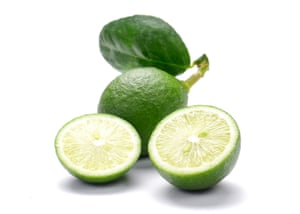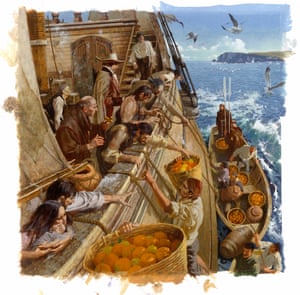When doctors and patients realised that scurvy had reappeared, in separate outbreaks in Zimbabwe and Sydney recently, they were stunned. “I couldn’t believe it,” Penelope Jackson, one of the Sydney victims, recalled, “I thought, ‘Hang on a minute, scurvy hasn’t been around for centuries’.”
Shame followed, as it often does with scurvy. “Does scurvy just affect developing countries?” asked Newsweek 24 of the Bulawayo emergency in Zimbabwe. “I couldn’t believe you could be obese and malnourished,” said Jackson. “We have sent a team to attend to it,” the Bulawayo city council curtly announced, by way of a plenary reply to such questions about the disease.
We forget about scurvy – deliberately perhaps. And we seem to forget as well just how simple it is to cure and prevent. As Jenny Gunton, the clinician at the Westmead Institute in Sydney, pointed out, scurvy is prevented if we don’t boil vegetables to a paste, and as for the cure: “It’s so easily treated with one vitamin tablet a day” or by fresh vegetables and fruit. When the rules for eating properly are neglected by a significant sector of the population, and their forgetfulness is allied with government cutbacks for social services, the outlook for outbreaks gets a lot grimmer.
The recent sieges in Aleppo and Mount Sinjar have doubtless been accompanied by unreported scorbutic outbreaks. Over the last few years there have been a steady trickle of stories of individual cases in Europe and the US – an eight-year-old in Wales died of cardiac arrest brought on by severe scurvy in 2011, and a toddler in Michigan who couldn’t walk and was successively tested for Guillain-Barré syndrome, osteomyelitis and cancer until physicians finally diagnosed scurvy.
But now that multiple cases are appearing in a single place, it suggests that either bad choices of diet are becoming more common, or that institutional food programmes are failing. Or that both are occurring simultaneously.
Vitamin C – the life sustainer
Human beings have, in common with a few other species (apes, fish, fruit bats and guinea pigs), an inability to synthesise vitamin C out of their own bodies. Although it contributes nothing to body mass, vitamin C is vital to life: without it death is inevitable. For centuries this was not really a problem, but once the western powers started sailing the great oceans of the earth in search of riches and territory, scurvy became a serious issue for sailors such as Bligh and his mutinous crew on the Bounty. Commanders and administrators who understood the benefit of frequent stops for refreshment, especially oranges, lemons and limes, could alleviate it. But no one discovered the secret of an entirely reliable preventive at sea because it was hard to preserve juice without destroying the crucial vitamin it carried.

The illness itself is actually a fairly simple progression. Once the content of vitamin C in blood plasma falls from 40 micromoles to 10, as it did in among diabetics at the Sydney Westmead Clinic, then the body stops producing collagen, the protein that glues us together and ensures our hydraulic systems operate smoothly. Cartilage disappears, hair and teeth fall out, bones weaken, skin bruises as the capillaries rupture, and soon it ulcerates: old wounds and fractures unknit, tendons stiffen and artery walls collapse.
Mucus tissue begins to rot, and come away from bone that is blackened by leaking blood. At the same time brain function is compromised. Vitamin C is an extremely efficient antioxidant that is the first line of defence against potentially damaging waste products generated by normal metabolic activity. It has a number of further functions, such as supporting the production of neurotransmitters such as serotonin and dopamine, the chemical messengers of the brain. Without them, neuronal signalling – feeling and thinking – can be compromised. And so the deficit of the vitamin contributes to the powerful and obsessive fantasies of scorbutic patients (usually of food) that alternate with profound lassitude, likened by one specialist to “a falling down of the whole soul”.
The illness brought on odd effects in the imaginations of victims, as historical accounts show. Tears were very common, even among rugged old tars. The Scottish naval physician Thomas Trotter remarked: “In dreams they are tantalised by the favourite idea; and on waking, the mortifying disappointment is expressed with the utmost regret, with groans, and weeping, altogether childish.” (Observations on the Scurvy, 1792, 44).
This soul hath been/ Alone on a wide wide sea:/ So lonely ‘twas, that God himself/ Scarce seemed there to be
“Our mental sufferings were such as defy description,” wrote Thomas Beale, author of the Natural History of the Sperm Whale and a favourite of Herman Melville, “and nothing but being placed within the same situation could convince those who have not the power to imagine its monotonous dreariness.” The repulsion felt by the eyewitness and the abjection endured by the victim of scurvy combined to make even this narrow band of sympathy uninhabitable. The great ballad of scurvy, Coleridge’s Rime of the Ancient Mariner, explores the radical loneliness of the scorbutic seaman and the impossibility of its story ever being fully told: “O Wedding-Guest! This soul hath been/ Alone on a wide wide sea:/ So lonely ‘twas, that God himself/ Scarce seemed there to be.”
Outbreaks of scurvy on a ship were, according to Captain William Bligh, disgraceful, a sign of bad management, so when his surgeon diagnosed scurvy on the Bounty he promptly had it re-diagnosed as rheumatism. On his 3,000 mile journey from Tahiti to Kupang he could not bear to look at the sick among his crew, whose leaden pallor and sunken eyes made them look like the walking dead.
And when Robert Scott’s company became scorbutic in Antarctica on his first expedition, he was furious with Ernest Shackleton for getting it so badly, and was glad to pack him off home. On the second expedition, when scurvy re-appeared, he said: “The great thing is to pretend that there is nothing to be alarmed at.” He even thought of suppressing any mention of it in his log. On whaleships Herman Melville noticed that scorbutic sailors would hide their symptoms as long as they could, for “sickness at sea is so heartily detested”.
The cause, and the cure, eluded scientists for years. It didn’t help that scurvy was often innocently confused with other nutritional illnesses. The blindness sometimes ascribed to scurvy was owing to lack of vitamin A.
It was not until 1933 that ascorbic acid was finally isolated. Up until that point nobody had been absolutely sure what it was in food that prevented or cured scurvy. Before that date the theories fell into two schools: that scurvy was caused by toxic food, which was false but not possible to disprove; or that there was some virtue present in food independent of its nutrient value – a sap, latex, or nitrous salt – which was true but not provable.
James Lind’s magnificent feat of clinical observation in 1747, when he proved that citrus fruit cured scurvy, was hindered from a full application by his belief that tainted food was indeed the cause of scurvy, and therefore while oranges and lemons definitely operated as a remedy, they could not (according to him) prevent the onset.
This caused Trotter the frustration shared by many historians of this malady when hindsight offers them an unobstructed view of important people making mistakes about its origin and cure. In his Observations on the Scurvy (1792) he cited the paragraph in Lind’s postscript (“I am fully confirmed … that whatever weakens the constitution, and especially the organs of digestion, may serve without any other cause to introduce this disease … even among such as live on fresh vegetables, greens, or the most wholesome diet, and in the purest air”), and added, “This paragraph . . . is one of the most unaccountable that has ever crept into the records of medicine”.

But even though we have known how to prevent scurvy with absolute certainty for nearly a century, still it recurs and resurfaces because of the ever present trickery of the fact that, as Gunton puts it of November’s outbreak, “It highlights a danger that you can consume plenty of calories yet not receive enough nutrients.” If people feel full, then they believe they are well nourished. This was the very same mistake the brilliant medical men of the 17th century were trying to correct. Very simply; sufficient body mass and malnutrition can co-exist.
If people feel full, then they believe they are well nourished
And still, populations throughout the world are proclaiming their ignorance of this truth. A survey of North American students discovered that 14% of those tested had concentrations in the blood below the medically accepted minimum level for normal health. An average person needs to consume up to 300 milligrams of vitamin C a day to maintain maximal circulating levels and preserve the estimated whole body pool of 1,500mg.
The reality is that we can be scorbutic even before we get bruising and stiff legs. The brain survives longer than any other organ, owing to the additional protection afforded the transport of vitamin C into the cerebrospinal fluid in which it bathes and from which the major brain cells are supplied with the antioxidants they need. But even that citadel will succumb when the level of the vitamin falls low enough.
More work is being done now on conditions such as sepsis, chronic fatigue syndrome, and symptoms of diabetes. But this research pales in comparison with the rise in the consumption of sugar, especially by young people, and the enforcement of recent policies of austerity by western governments. Figures quoted in the Guardian at the same time as the Sydney outbreak revealed that diagnoses of malnutrition in Britain have increased by 44% in the five years to 2015. Ignorance about food among individuals and misguided state policies concerning diets of the young and the elderly: these are the nurseries of scurvy, and always have been.
Jonathan Lamb is Mellon Professor of the Humanities at Vanderbilt University and author of Scurvy, The Disease of Discovery.
With thanks to Professor James May and Professor Fiona Harrison, Vanderbilt University Medical Centre, who helped with the medical aspects of scurvy.
Join our community of development professionals and humanitarians. Follow @GuardianGDP on Twitter.
Black bones, gangrene and weeping: the unwelcome return of scurvy
Hiç yorum yok:
Yorum Gönder